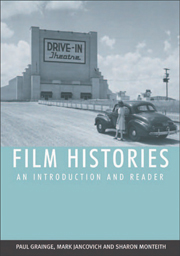Book contents
- Frontmatter
- Contents
- Preface
- Part I Film History from its Origins to 1945
- 1 The Emergence of Cinema
- 2 Organising Early Film Audiences
- 3 Nationalism, Trade and Market Domination
- 4 Establishing Classical Norms
- 5 The Age of the Dream Palace and the Rise of the Star System
- 6 Competing with Hollywood: National Film Industries outside Hollywood
- 7 The Rise of the Studios and the Coming of Sound
- 8 Realism, Nationalism and ‘Film Culture’
- 9 Adjustment, Depression and Regulation
- 10 Totalitarianism, Dictatorship and Propaganda
- 11 The Common People, Historical Drama and Preparations for War
- 12 Wartime, Unity and Alienation
- Part II Film History from 1946 to the Present
- Bibliography
- Copyright Acknowledgements
- Index
8 - Realism, Nationalism and ‘Film Culture’
from Part I - Film History from its Origins to 1945
Published online by Cambridge University Press: 05 August 2013
- Frontmatter
- Contents
- Preface
- Part I Film History from its Origins to 1945
- 1 The Emergence of Cinema
- 2 Organising Early Film Audiences
- 3 Nationalism, Trade and Market Domination
- 4 Establishing Classical Norms
- 5 The Age of the Dream Palace and the Rise of the Star System
- 6 Competing with Hollywood: National Film Industries outside Hollywood
- 7 The Rise of the Studios and the Coming of Sound
- 8 Realism, Nationalism and ‘Film Culture’
- 9 Adjustment, Depression and Regulation
- 10 Totalitarianism, Dictatorship and Propaganda
- 11 The Common People, Historical Drama and Preparations for War
- 12 Wartime, Unity and Alienation
- Part II Film History from 1946 to the Present
- Bibliography
- Copyright Acknowledgements
- Index
Summary
The coming of sound was an important phase in the bid for naturalism in the cinema and by the end of the 1920s many filmmakers across different national cinemas were in pursuit of forms of cinematic realism that would convey ‘modernity’. The cinema was one of a number of cultural, technological and political developments, or transformations, that coalesced in the larger formation of modernity. The 1920s would also see the beginnings of an intellectual tradition that read cinema as a self-reflexive medium and a distinctively public phenomenon that might translate, or at the very least comment on, modernity for a mass audience. A burgeoning film culture began to involve critics and reviewers as taste-makers, categorising and theorising about films as art, and film journals and magazines as the forum in which the patrons of film clubs and societies could begin to find the films they enjoyed contextualised.
New documentary styles emerged although the term ‘new’ may seem misleading when it is remembered that Lumière's first frames were actually of workers leaving his factory after their day's work and that early cinema from most national vantage points sought to exploit new technology to find the ‘truth value’ in everyday realities from its beginnings. The cinema was beginning to experiment with realism and its alternatives and by the late 1920s, the term ‘documentary’ was in popular usage and in Hollywood too directors aimed at capturing a level of verisimilitude that would amaze audiences.
- Type
- Chapter
- Information
- Film HistoriesAn Introduction and Reader, pp. 165 - 186Publisher: Edinburgh University PressPrint publication year: 2007



